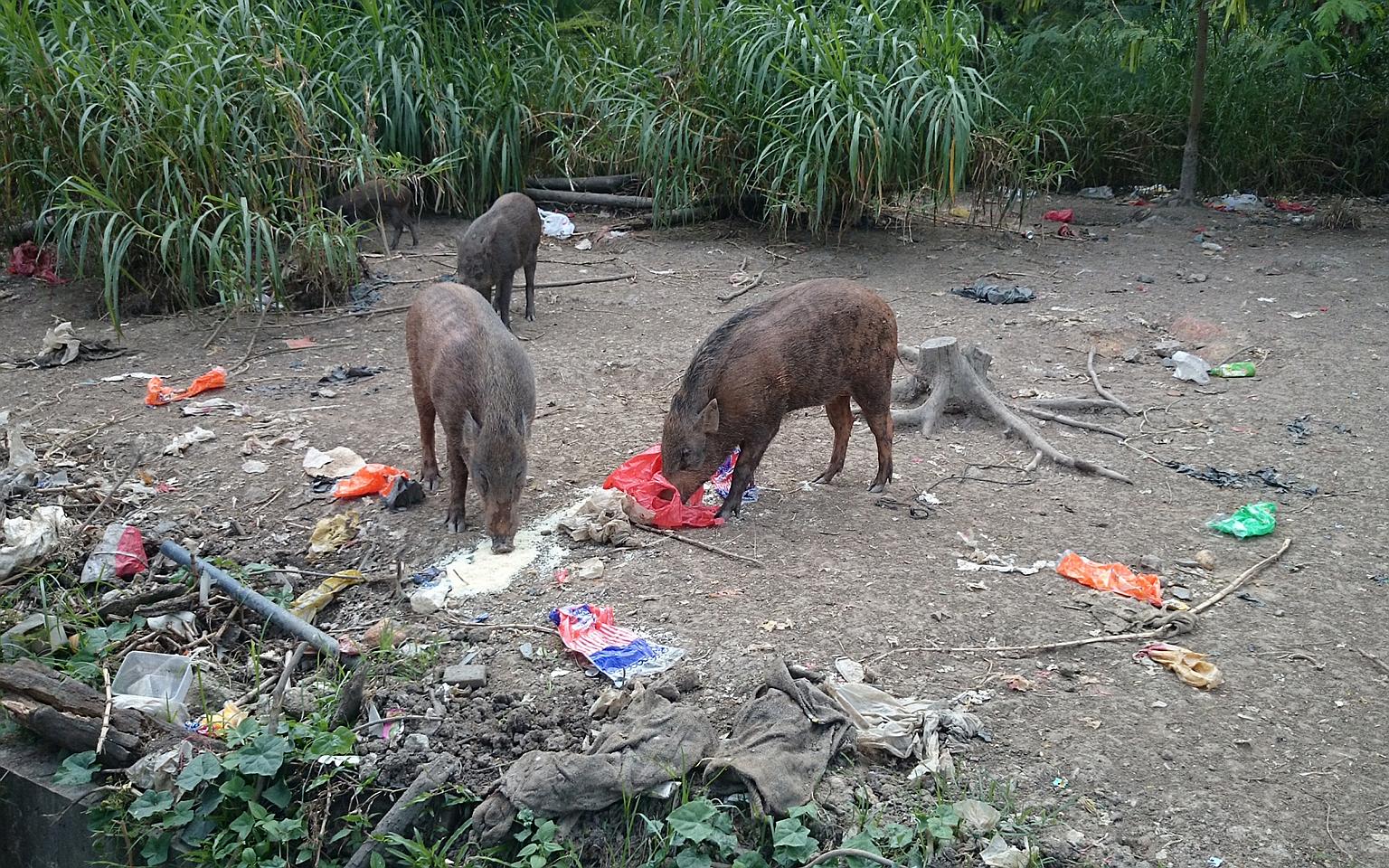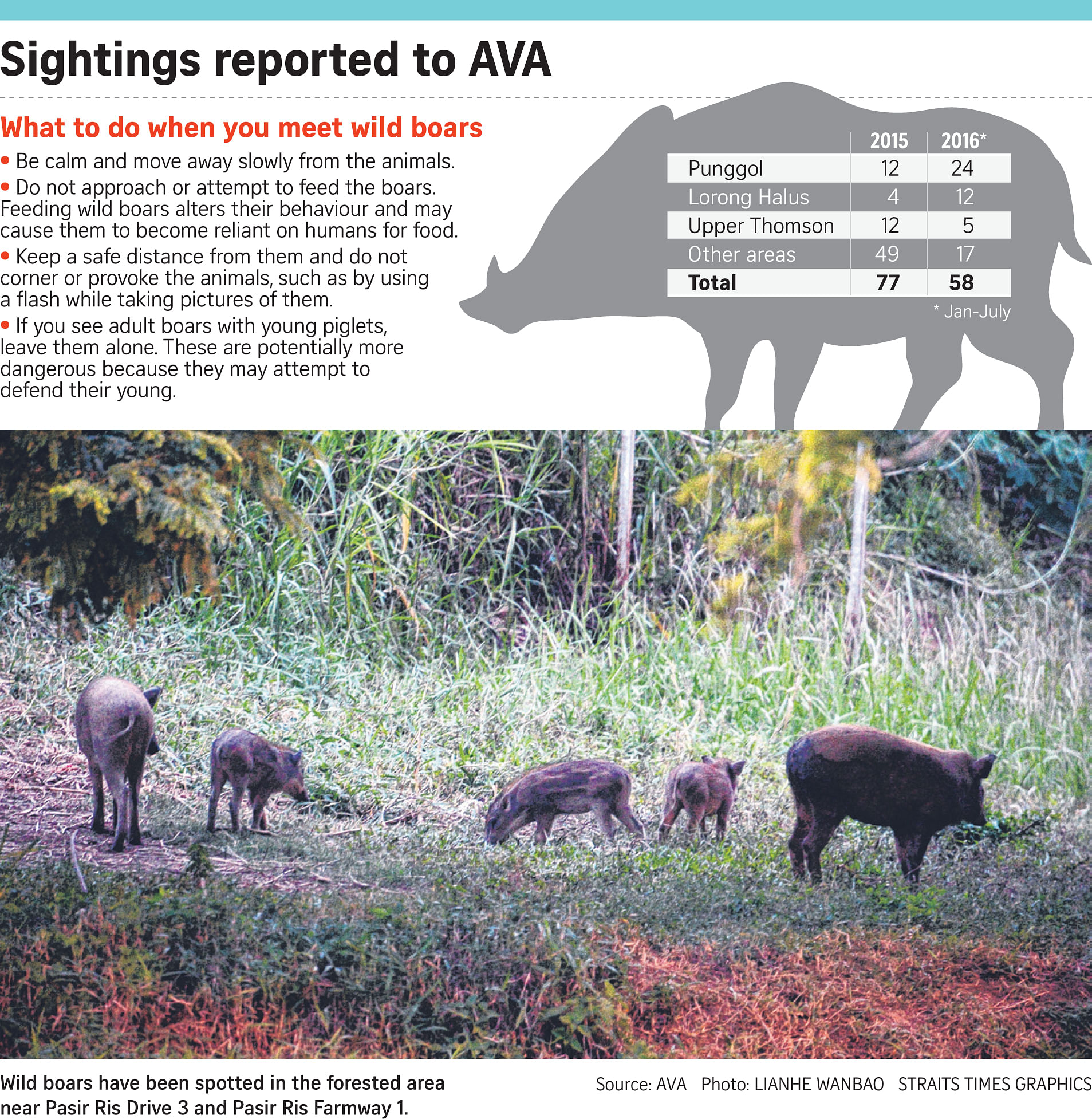More boar sightings reported in Punggol
Rise may be due to new developments rather than boar population growth, says expert
Sign up now: Get ST's newsletters delivered to your inbox

People have been seen feeding wild boars in the Lorong Halus area, raising concerns.
TNP FILE PHOTO
Rachel Oh, Chew Hui Min
Follow topic:
Some Punggol residents are squealing in delight at the prospect of more wild boars being seen in the area, while others are alarmed.
Sightings of the animals in Punggol have doubled from last year, according to the Agri-Food and Veterinary Authority (AVA).
Across the island, from January to July this year, AVA received 58 instances of wild boar-related feedback compared to 77 for the whole of last year, AVA told The Straits Times on Tuesday.
But 24 sightings have been reported in Punggol in the first seven months of the year alone, double the figure of 12 last year.
The number tripled in Lorong Halus in Pasir Ris, with 12 incidents from January to July, compared with only four last year.

However, sightings in other areas of Singapore have gone down, according to AVA. Five were sighted in Upper Thomson from January to July, down from 12 last year, and 17 in other parts of Singapore, down from 49 last year.
Housewife Chu Wei Ping "freaked out" when she encountered a wild boar a few months ago in Punggol East Park, where she frequently jogs. "I was afraid it would charge at me, so I moved away quickly," she said.
But her fears were unfounded, said wildlife consultant Subaraj Rajathurai, 53, who pointed out that the idea of wild boars charging at people is a misconception.
"As long as you don't get between mums and babies or provoke them, there is no problem," he said.
Mr Subaraj explained that the rise of wild boar sightings in Punggol is not necessarily linked to their population growth.
It could be due to more recent urban development in the area, such as new homes.
"There is an increase in areas where their habitats have been cleared, making the wild boars more visible. Once they get used to people, they will wander out into the open and will get seen more easily," he said.
Another contributing factor could be the absence of predators such as big cats and snakes, he said.
Ms Anbarasi Boopal, deputy chief executive at the Animal Concerns Research and Education Society, said the recent spike in sightings could be linked to residents who feed the boars.
"(The rise in sightings) is quite recent, so it could be the developments in the area that cause more people to use the place, which may, in turn, lead to people feeding the boars," she said.
In June, a woman was caught on video feeding about 10 wild boars that inhabit an area around the Lorong Halus Jetty in Pasir Ris. The video raised concerns after it was posted on a Facebook group for cycling enthusiasts.
As for why boar sightings reported to AVA fell in Thomson, Mr Subaraj said it could be that the recent clearing of palm and rubber trees there led to the wild boars wandering off - seeds of palm and rubber trees form part of the boars' diet.
He also noted that there have been illegal poaching activities in the area, with a number of traps found.
Capturing, displacing or feeding any animal in national parks or nature reserves is an offence, and an offender can be fined up to $50,000, jailed for up to six months or both.
Culling to control number
In 2008, a man was fined $4,000 for feeding a monkey in the Mandai nature reserve, near Old Upper Thomson Road.
Public safety and nuisance concerns over the wild boars have led to "control operations" to cull the boars, said AVA and the National Parks Board (NParks) in a joint statement.
AVA has trapped 53 wild boars since May.
"The boars were humanely euthanised as relocation options are not available in land-scarce Singapore," the agencies said.
In the longer term, NParks is carrying out population studies to formulate policies for wildlife population management.
The board is tracking the range and movement of the animals within the Central Catchment Nature Reserve using global positioning system collars, said the agencies.
While some people are fretting over the boars, Punggol resident Shaleen Goh, 19, is excited about the presence of wild boars in her area.
"It will help to raise awareness about wild animals in Singapore, and hopefully make our society more accepting towards sharing our space with them," the polytechnic student said.

